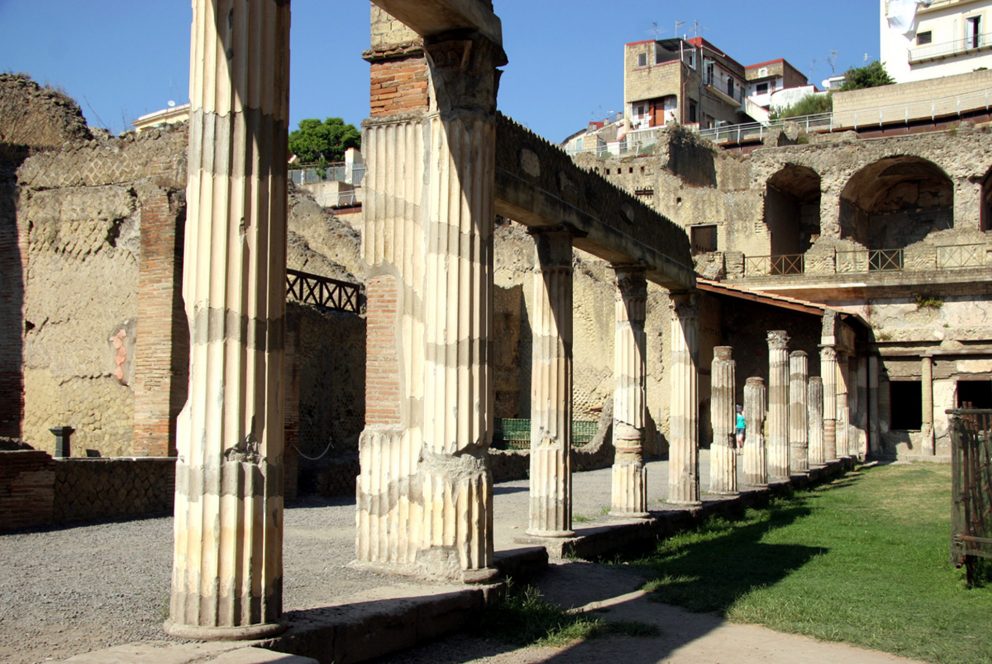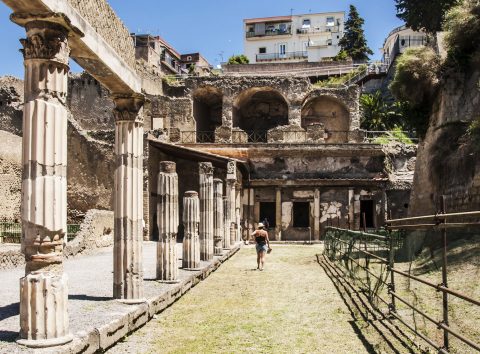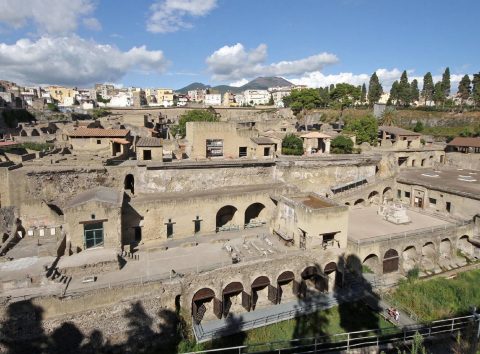Herculaneum
Another excellent tourist destination, thanks to its archaeological heritage, the excavation of the Roman city buried by the eruption of Vesuvius in 79 ad . Herculaneum is a municipality with an area of 19.64 km² and home to 55.663 inhabitants; it is situated to the South-western slopes of Mount Vesuvius, overlooking the Gulf of Naples. Legend has it that it was founded by Hercules, the mythical Greek hero, when, after accomplishing one of his valorouse missions in Iberia he came Italy and erected a small town between Naples and Pompeii and named it after himself Herculaneum. Some historical data confirm, however, that the city may have originated in the first century BC and that its name derives from the Greek Erakeion.
It has been inhabited by the Oscans, Etruscans, Samnites and Romans, and during the time of Julius Caesar it became a municipium, in other words a town founded by the Romans but not incorporated in the State. This initiated a period of prosperity for the city, which, for its beauty and for the favourable climate, became a tourist destination of Roman nobility who built villas and residences. The eruption of 79 ad, however, destroyed this refined city covering it with lava, mud and submerging all its homes and objects. On this area tghen arose Resina, the modern city which kept this name until 1969 when it was then called Ercolano.
There are several places of interest in Herculaneum, the most important though are the archaeological excavations that, unlike Pompeii, were buried by mudslides and lava, and not by ash, lapilli and thus one can still see preserved the furnishings and wooden structures. The rediscovery of ancient Herculaneum began in the 18th century, thanks to the Austrian count Elboef, and then continued in the 800 and resumed again in 1927 by Amedeo Maturi, and are still ongoing today. Herculaneum appears to us today only in a part of its extension, the one closest to the sea, while still buried are part of the Forum, temples, numerous homes and necropolis, especially for the fact that they are situated below the modern town of Resìna.
Sightseeing starts at Carduine III, with the visiting of numerous homes. Among the buildings of the excavation of vital importance is the theatre, approximately 26 m of deep, capable of hosting 3,000 spectators aalong 10 rows of steps; the Basilica decorated with marbles and paintings, the spa with gym,the Home of ARGOS with an arcade of 20 columns and 6 pillars and the Peristilio with its columns, a symbol of nobility, and the famous papyri of Herculaneum partially preserved in the Naples National Archaeological Museum. Among the most spacious and stately homes is the Home of the hotel, which is preserved intact in its structure, the adjacent Home of the skeleton, named after the human remains that were found in it. Then there is the home of the Atrium mosaic, so called thanks to rtge excellent ptresevations of its floorings and which has, on a wall, a mural dedicated to Diana and Actaeon. Then there is a half-timbered House, excellent example of housing of the time, with its colonnade that holsd the balcony and that rests directly on the sidewalk. Then there is the Samnite House, which has preserved its characteristic of dwelling for nobles due to the multiplicity of frescoes present on its walls. The Workshop next to the House of Neptune and Amphitrite still has intact its furnishings and amphoras which contained goods as well as cereals and legumes charred by the lava.
The decumanus maximus is the area richest in history of Herculaneum, although only a portion has been brought to light. From here was the access to the Foro which has not yet been entirely excavated. The House of the bicentennial, in which was found a cross which is first sign of Christianity in those places, it is so named because it took two centuries, from the beginning of excavations, before being brought to light. Herculaneum was also equipped with Spas, there was a porch surrounded by a Colonnade with a modern gym, divided between male and female areas.
There are also places of interest in modern city: the main road, Corso Resìna, which links Ercolano to Naples, owns a stretch known as the Golden Mile, due to the presence of major architectural works: le Ville Vesuviane (some restored by famous sculptors or architects such as Vanvitelli) Villa Aprile (now aluxury Hotel ‘Miglio d'Oro)’, Villa Battisti, Villa and Parco della Favorita, the residence of King Ferdinand IV of Bourbon, and so named because he remembered his wife Maria Carolina of Austria, hid favourite from Shonbrun, Villa Campolieto, partly created by Luigi and Carlo Vanvitelli, locati9on where cultural events, shows and concerts take place.
An other places of artistic interest is the Basilica of Pugliano, placed at the end of via Pugliano, famous for the ancient marketplace of used clothing, one of the oldest in Italy.
Useful information:
how to get to Herculaneum: Distance from Sorrento: 40 km
by car/moto: Follow the S.S. 145 in the direction Naples and exit at the roundabout on the motorway A3 at Ercolano
By train: with the Circumvesuviana line to Sorrento, Naples, Ercolano Scavi station.
By sea: line 1 Metro del Mare, embarking from Marina Piccola in Sorrento
Useful numbers:
municipal police: tel. 0817776904
Post offices: Via Panoramica 298, Via Benedetto Cozzolino, 56
Tourist Office: Corso Resina, 39, tel. 0817881243





